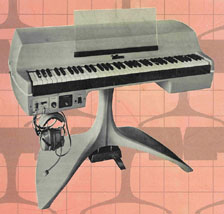
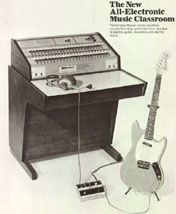
Harold Rhodes had music education in mind when he developed his first pianos, and this fervent interest continued when the first professional Rhodes models were introduced in the mid-1960's. The Fender Rhodes KBS 7024 Keyboard Instruction System was a student version of the 73-key piano with a space age design, featuring a contoured fiberglass body. The concept behind these pianos was to have a classroom full of them, with the teacher operating an instructor console that allowed him or her to "listen in" on individual students.
 |
 |
The first student pianos from 1965-66 were gold in color, with a single- or dual-pedestal base and a metronome/volume control box mounted on the underside. The amplifier for these pianos was actually a bench that the student would sit upon. In 1967, the design was improved to include the speaker on the underside of the piano itself. Colors for this second generation included a bright yellow (standard), as well as Avocado Green, Fiesta Red and Cinnamon Red. The base for these pianos had a "fishtail" design with a white pinstripe down the front of the pedestal, and the metronome was integrated with the piano body. A third generation was introduced in 1968, with a more contoured fishtail base (sans pinstripe) and Avocado Green as the primary color. The metronome component in these later models featured a "signal instructor" switch, a headphone amplifier and a microphone input used for communicating with the teacher. An instructor version of the piano was also available, with the only difference being the interface on the control unit.
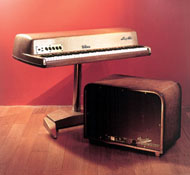 |
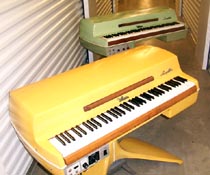 |
 |
 |
 |
|
1960's Student Piano photos provided by Kenneth Manning |
||
In 1969, the Rhodes KMC I Keyboard Music Center replaced the "Jetsons" model, coinciding with the cosmetic transition from silver harp covers to black in the rest of the Fender Rhodes product line. The KMC I was essentially a one-piece Suitcase 73 with a scaled-down amp (15W with two 10" speakers) and no Vibrato effect. The control unit from this period had the same features as the KBS 7024.
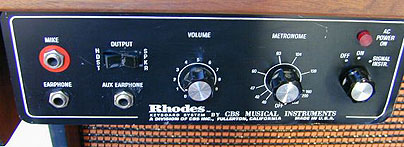 |
|
control unit photo provided by Kaz Iwase |
The new design was based on a walnut cabinet, making it suitable for use as a living room piano, while retaining the black plastic harp cover and "Seventy-Three" logo found on any other Mark I. A home version of the KMC I was also available, replacing the metronome unit with a headphone jack and a built-in cassette recorder. A second foot pedal was added for use as a volume control, similar to the swell pedal on a Hammond organ. In 1974 the KMC I was renamed the "Rhodes Home Piano" for marketing purposes, as CBS was discontinuing the Rhodes educational program at that time.
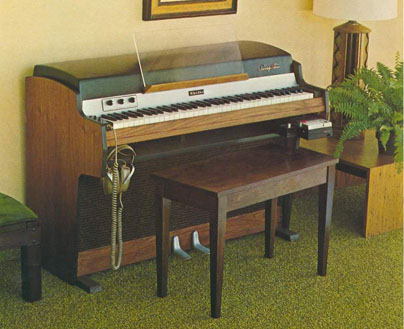 |
What has become officially known in inner circles as the Rhodes Home Piano was a similar design introduced for a very brief period in 1977, with an all-walnut cabinet, built-in amplifier and gold stamped logo on the front panel. Only about 250 of these were built, with the very last run of cabinets being salvaged from a fire at the factory, completed by Harold Jr. and distributed to members of the Rhodes family(!).
 |